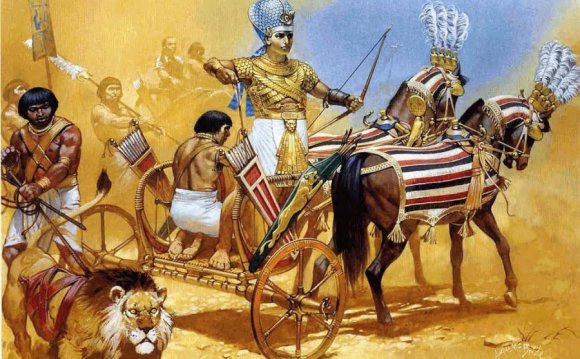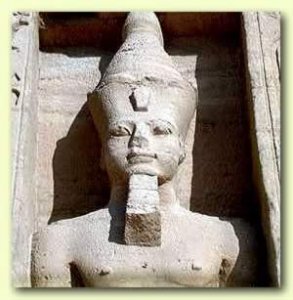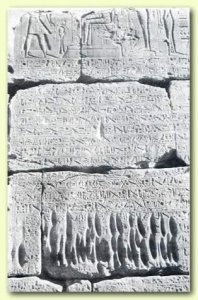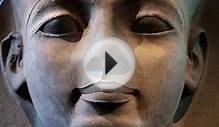

The Pharaoh Who Made Peace with his Enemies
And the First Peace Treaty in History
By Dr. Sameh M. Arab
Ramses II", who reigned for 67 years during the 19th dynasty of the 12th century BC, was known as "Ramses the Great". His glories surpassed all other Pharaohs, and Egypt reached an overwhelming state of prosperity during his reign. Not only is he known as one of Egypt's greatest warriors, but also as a peace-maker and for the monuments he left behind all over Egypt. He was the first king in history to sign a peace treaty with his enemies, the Hittites, ending long years of wars and hostility. The treaty can still be considered a conclusive model, even when applying todays standards.
Who are the Hittites?
Their rise and hostility with Egypt: The Hittites were a minor nation in Anatolia, who started to penetrate peacefully east and west through monopolizing political power in the Near East. By the second millennium BC, they became a great power that finally replaced the Babylonian state around 1530 BC. They started challenging the Egyptian Empire during its decline under the reign of Akhen-Aton (18th dynasty). International correspondence from the Asian princes in Palestine and Syria (known as the Amarna Letters) were sent to Akhen-Aton and his court requesting help, and warnings of the Hittites growing influence. The pharaoh unfortunately neglected them and never replied. This resulted in Egypt loosing control over considerable territory in Syria when aggressors, aided by the Hittites, invaded. After the death of Akhen-Aton, and the murder (or death) of his successor Tut-Ankh-Amon, his wife (and Akhen-Atons daughter), "Ankh-Esenpa-Aton", attempted a diplomatic coup with the Hittites. In order to secure her position, she sent a secret letter to their king asking him for a son whom she could marry and make pharaoh. As this offer was astounding, the king suspected treachery and sent an ambassador to test the queens true intentions. In response to her assurance, the king sent his son. However, he was captured and murdered by the Egyptian commander of the army, Horemheb (who later became pharaoh). Hostility between Egypt and the Hittites was further augmented.
The war between Egypt and Hatti:
With the rise of the 19th dynasty in Egypt, "Seti I" began to reestablish Egypts power in the Near East. Within the first two years of his reign, he was able to restore all of Palestine and the city of Kadesh to Egyptian control. Afterwards, a short-lived truce was signed between the two empires.
 During the reign of Seti I's son, "Ramses II", advances were made against Syria that reached Kadesh one more. The resulting battle is one of the most famous in Egyptian history. It lasted four days, and initially Ramses was losing the battle. However, his army managed to fight bravely until reinforcements arrived, turning the defeat into victory. The Hittites asked for a cease-fire, and Ramses officers advised him to make peace, saying,
During the reign of Seti I's son, "Ramses II", advances were made against Syria that reached Kadesh one more. The resulting battle is one of the most famous in Egyptian history. It lasted four days, and initially Ramses was losing the battle. However, his army managed to fight bravely until reinforcements arrived, turning the defeat into victory. The Hittites asked for a cease-fire, and Ramses officers advised him to make peace, saying,
"There is no reproach in reconciliation when you make it."
After the death of the Hittite king, "Hattusili III" usurped the throne from the legitimate prince who fled to Egypt and was granted political asylum by "Ramses II". Hittite documents record Hattusilis complaint:
"When I wrote to him: send me my enemy, he didn't extradite him. Therefore there was anger between me and the King of Egypt."
While another round of war was on the horizon, both empires were under pressure with the Hittites were facing the reemerging Assyria in Mesopotamia, and Egypt was facing a threat from the Libyans in the west. Diplomatic negotiations took place for two years until a peace treaty was concluded in the 21st regal year of Ramses reign with "Hattusilis III" in 1280 BC.
The peace treaty:
Egypts acceptance of a peace treaty that would end the war in Syria meant that there would be no chance to restore Kadesh and Amuru. However in return for this sacrifice, the dispute between the two countries would end with a clear line of demarcation between the Egyptian and the Syrian territories. Moreover, Egypt guaranteed the Syrians the right to use their Phenecian harbors, while the Hittites agreed to allow Egyptians free passage to the north as far as Ugarit without interference. This was a privilege lost for more than a century.
Two copies of the treaty were recorded, one in hieroglyph and the other Akaddian, and both still survive. Both copies are identical except for the overture, in which the Egyptian version stated that it was the Hittite king who demanded peace, whereas in the Hittite version, it was Ramses who sent them emissaries. The Egyptian version was recorded on a silver plaque presented by Hattusili to Ramses, then copied on stone at the Karnak and Ramesseum temples.
Akaddian Version of Treaty
The treaty was composed of 18 articles. After a long introduction recording the kings titles and referring to establishment of good fraternity and peace, one article was included to exclude any further attacks on the other countrys territories:
"Reamasesa, the great king, the king of the country of Egypt, shall never attack the country of Hatti to take possession of a part (of this country). And Hattusili, the great king, the king of the country of Hatti, shall never attack the country of Egypt to take possession of a part (of that country). "
Hattusili and his Wife, Puduhepa
Two articles follow that established the mutual alliance against any foreign attack on either country:
"If a foreign enemy marches against the country of Hatti and if Hattusili, the king of the country of Hatti, sends me this message: "Come to my help against him", Reamasesa, the great king, the king of the Egyptian country, has to send his troops and his chariots to kill this enemy and to give satisfaction to the country of Hatti."
"If a foreigner marches against the country of Egypt and if Reamasesa, the great king, the king of the country of Egypt, your brother, sends to Hattusili, the king of the country of Hatti, his brother, the following message: "Come to my help against him", then Hattusili, king of the country of Hatti, shall send his troops and his chariots and kill my enemy. "
The treaty then included three articles establishing mutual collaboration against any internal mutiny or coups in either country:
"If Hattusili, the great king, the king of the country of Hatti, rises in anger against his citizens after they have committed a crime against him and if, for this reason, you send to Reamasesa the great king, the king of the country of Egypt, then Reamasesa has to send his troops and his chariots and these should exterminate all those that he has risen in anger against. "
"If Reamasesa, king of the country of Egypt, rises in anger against his citizens after they have committed a wrong against him and by reason of this he sends (a message) to Hattusili, the great king, the king of the country of Hatti, my brother, has to send his troops and his chariots and they have to exterminate all those against whom I have risen in anger. "
See also:MORE TRANSLATION VIDEO












